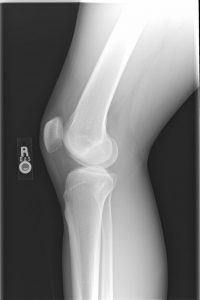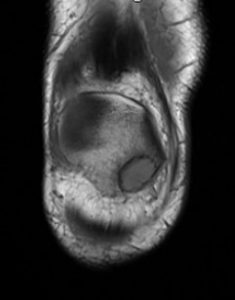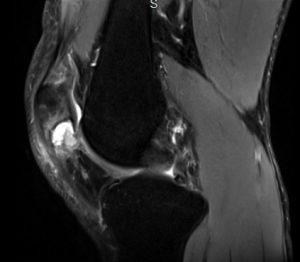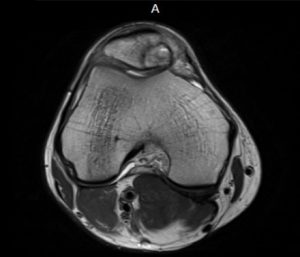
CASE OF THE DAY 9 NOV
Question:
22 year-old man with chronic knee pain for several months.
What is the best diagnosis?
 |
 |
 |
|
 |
 |
 |
- ANSWER:
4) Chondroblastoma
- Findings:
Radiograph findings:
Lateral knee x ray shows a faint lytic lesion in inferior pole of the patella.
MRI findings:
- Well defined osseus lesion.
- Location: Inferior pole of the patella with endosteal scalloping of the cortex
- Signal characteristics: Iso-hyper intense on T1W, predominantly hyperintense on T2W
- Homogeneity: Predominantly homogenous, heterogenous posteriorly
- Zone of transition: Narrow. Well-defined with sclerotic margin and mild subjacent
- Periosteal reaction: Mild inferiorly along the cortex.
- In-phase and out-of-phase: No signal drop ( in favor of absence of intracellular fat)
Hints:
Patella is one of the epiphysis-equivalent sites, therefore, differential diagnosis of an epiphyseal lesion apply.
Epiphysis-equivalent sites:
Ribs, greater and lesser tuberosities (humerus), small bones of the wrist, acetabulum, greater and lesser trochanters (femur), patella, tibial tubercle, calcaneus, small bones of the midfoot, any apophysis
Differential diagnosis of epiphyseal lesions:
Benign:
Subchondral cyst (geod)
Erosion (inflammatory arthritis, PVNS, synovial osteochondromatosis)
Osteomyelitis ( < 18 months old, TB and fungus in adult)
Chondroblastoma ( open physis)
Giant cell tumor ( closed physis, extending from metaphysis)
Osteoid osteoma
Malignant:
Clear cell chondrosarcoma
- Discussion:
- Chondroblastoma is a rare primary benign cartilaginous neoplasm of bone that accounts for less than 1% of all bone tumors and less than 3% of benign bone tumors .
- Chondroblastoma arises from a secondary ossification center in epiphyseal plates and apophyses of a long bone in patients between 10 and 30 years old ( 70% occur during active epiphyseal plate growth) and is more prevalent in males (2:1).
- Rarely chondroblastoma is associated with pathologic fracture. A few cases of patellar chondroblastoma and ABC Coexistence has been reported.
- The patella is an uncommon location for bone tumor occurrence and development. Most tumors of the patella are benign. The most common benign lesions are chondroblastoma, giant cell tumor, and aneurysmal bone cysts . Malignant lesions include metastasis, osteosarcoma, lymphoma, and hemangioendothelioma. The most common tumor-like lesion is a brown tumor in hyperparathyroidism.
- Local pain of several months’ duration and swelling are the most important symptoms of benign chondroblastoma and affect most patients.
- Radiographic features include a lytic lesion involving the epiphysis with a thin border of sclerosis. About half of all cases demonstrate central punctate calcification.
- Chondroblastomas may or may not show a chondroid matrix on radiographs due to their varying composition of hyaline cartilage or fibrocartilage.
-
Lang Y, Yu Q, Liu Y, Yang L. Chondroblastoma of the patella with pathological fracture in an adolescent: a case report. World J Surg Oncol. 2019 Dec 12;17(1):218.
-
Majdi, Ben et al. Chondroblastoma of the Patella: A Case Report. Oncology & Cancer Case Reports.
Courtesy of Parham Pezeshk,MD, Assistant Professor, Division of Musculoskeletal Imaging Department of Radiology, University of Texas Southwestern Medical Center,Dallas,TX
